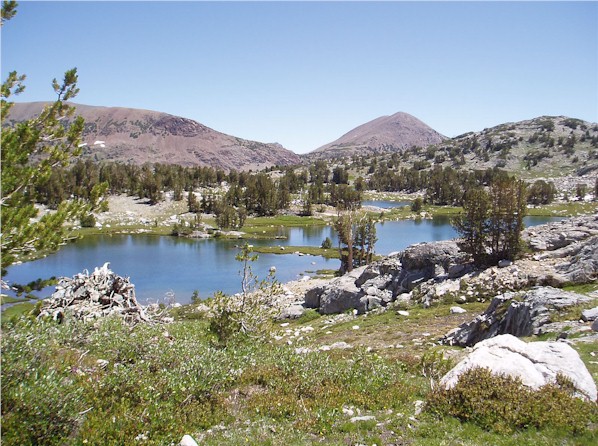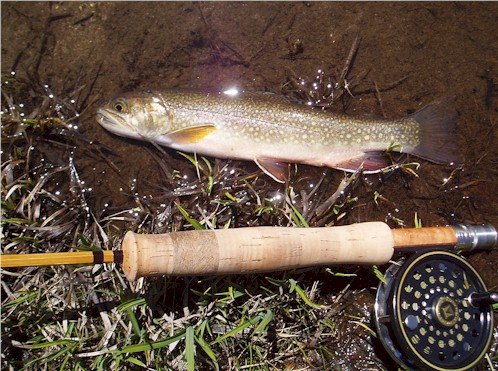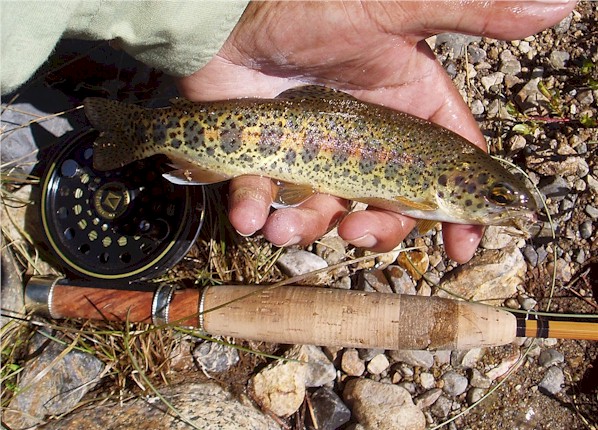|
|
|
|
|
August 11 & 12, 2006- Shepard Crest and Tioga Pass revisited Time:
10:30am - 3:30pm Saturday, 11:00am - 1:30pm Sunday Narrative:
Saturday started much like last Saturday- breakfast at the Saddlebag Lake Resort. Again I picked up a copy of Barbier's "Eastern Sierra Fishing Guide for Day Hikers" and after a brief discussion with the owner, arranged to pick up 6 more the following day. It seems they purchased the entire remaining stock from the supplier and have an ample supply. I mentioned that I was picking the book up for a few other fellows and she allowed me to purchase the 4 I needed plus a few extra.
I hit the trail a little earlier than last week and was at the lake by 10:30am. Last week, there was no trail to the lake and this week was the same. My friend and the guide book both say to follow the trail to the old research station, which I used as shelter in last week's thunderstorm, and then cross the creek and follow the creek to the lake. Supposedly, there's an old "fisherman's trail" but I didn't find such a thing. After crossing the creek the terrain didn't seem "creek follow friendly" so I opted for a cross country route. From last week's journey I had a pretty good bead on where this weeks lake would be so I left the creek and made my way.
Returning to this area truly gave me an appreciation for the terrain I scaled last week.
This weeks trip would be much simpler and I had soon reached a saddle from which I had 360 degree view of the surrounding range.
On a long hike this would have been the perfect spot to rest or perhaps picnic on a shorter hike. I took a break for several minutes, taking pictures and letting the scenery sink in before I was chased off by mosquitoes. The lake was just over the next rise and again, it was a magnificent sight.
The Lake Which Will Not Be Named is a chain of lakes really. One large hour glass shaped lake or two lakes, a large lake and a small lake with a small island between both if you like and additional lake a little higher. The higher lake is connected to the lower by a small stream. I like to think of it as three lakes and spent most of my time on the lower two.
When I arrived there were several fish rising in the smaller portion of the first lake. This lake was shallow for the first 25 feet or so and then slowly dropped off. The different zones in the lake were very distinct- brownish shallows, an aqua green mid level trailing off into a darker blue as the lake deepened. The fish were in that zone between the mid level and deep water and at times seemed to come from nowhere as the surface exploded. More often than not resulting in a heavy fish on the end of my line.
These fish were heavy. I'd come to this lake looking for Kamloops Rainbow trout, known for their "hot" or hard fighting nature. I don't think I found very many. In fact, except for the two rainbows I'd actually seen, the third fish was the largest or would have been the largest of the trip had I not suffered the ill fated Long Distance Release.
I suspect this may have been due to the full moon or nearly full moon of the night before. The Kamloops weren't on the bite but the Brookies were. These Brook Trout weren't like the fish I'd found in the lake one thousand feet higher. They weren't stunted and they weren't biting as freely as Brookies tend to do but once I figured out the pattern, it wasn't too difficult to find some fast action. Sight fishing was the name of the game.
I think I may have landed my largest Brook Trout ever on this trip. An eleven inch fish that was sipping midges at the inlet stream. I'd scared it out of position on my first approach but after sitting and waiting a bit, the fish returned; after missing several strikes and changing to several different flies, I finally landed her on a size 20 Parachute Adams.
The Forks of the Dana Fork
On Sunday I fished what I'll call the Forks of the Dana Fork. The Dana fork is quickly becoming a favorite place for me to practice my dry fly skills. Last week I caught mostly Brook Trout and Brown Trout but since I was thwarted in my quest for Goldens last week and practically skunked on Kamloops Saturday, I was in search of something in the genus Oncorhynchus. In my experience, Rainbow Trout in the Dana Fork aren't as numerous as Brookies and Brownies but they are there and along with a little exploring, I wanted to catch one.
I still haven't quite figured out how to fish for the different species in this stream. The Brown Trout seemed to like the slower pockets and shade under the bank and brush. The Brookies seemed to like the tails of runs as well as the cushion in front of rocks and the rainbows were in the very deepest and fastest water but that wasn't always the case. Last week the Brook Trout seemed to have an affinity for mayflies and while that was still somewhat true this week, so many more fish hit the Elk Hair Caddis that I stopped fishing the mayfly quite early on.
I fished two dry flies- a ratty olive EHC that has probably caught well over 50 fish and a newish, higher floating yellow EHC. I'd spotted a small stonefly earlier and though I couldn't catch it, I guessed it might have been a Little Yellow Sally. I'd guessed this mostly because all the stonesflies I've seen of this size in California have been Little Yellow Sallys. The yellow EHC wasn't nearly the killing fly as the olive but it did catch my first Rainbow. In fact, I only caught two rainbows and they were both out of the same hole, a confluence between two tribs of the Dana Fork.
The rainbows of the Dana fork are quite unique. They have a yellow olive body with speckles and a magenta stripe. I wonder if these fish were at one time planted or are descendants of the Coastal Rainbow Trout that originally inhabited the Tuolumne River. They are similar, though richer in color, to some of the Tululawiak trout. The trout in Illilouette I believe are planted as no fish could ford the several falls that exist between the creek and the Merced River.
I fished both forks of the Dana. It's interesting to note that on the South Fork of the river I caught only Brook Trout. Good sized Brookies for the most part. On the North Fork, I caught both Brookies and Browns. I wouldn't catch another rainbow until I dropped my fly in the water for the last time, right where I parked my car. He was a small fellow and doesn't really count as my fishing was done for the day and I was simply curious to see if I could pull a fish out of what was probably the heaviest fished run on the river.
Previous Yosemite / Ansel Adams Wilderness Chronicle Next Yosemite / Ansel Adams Wilderness Chronicle
|








